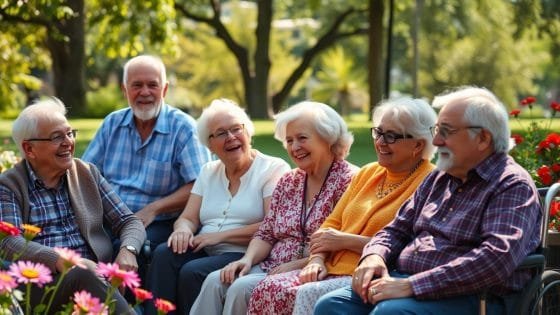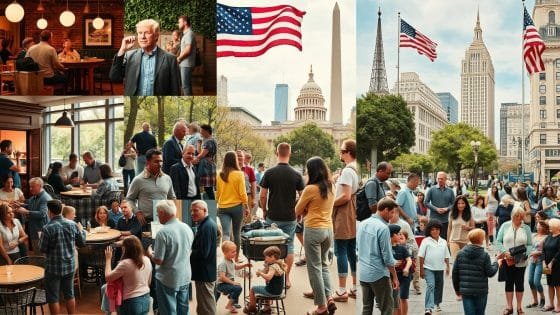The USA is seeing a big change, with over 55 million people aged 65 or older. This group makes up 16% of our total population. It’s important to know how to talk to USA elders with respect.
Senior citizens in America do a lot for us. They volunteer, help with caregiving, and work in the economy. About 20% of people 65 and older still work, with those 65 to 74 growing the fastest.
Talking to elderly Americans needs to be thoughtful. They face many challenges and need our help. The ICC is working on a national plan to improve their lives.
Our words matter a lot. Ageism can hurt older people’s health and happiness. By being careful with our language, we can make a better world for USA elders.
Understanding Communication Etiquette with USA Elders

Talking to older adults in the US needs care and respect. The number of American retirees is growing. This means we must be sensitive to their cultures and experiences. Let’s look at how to interact with seniors in the USA.
Respectful Language and Terminology
When talking to older adults, use language that includes everyone. Say “older adults” or “people over age X.” Don’t use words like “elderly” or “senior citizen.” The term “geriatrics” is for medical use, not for people.
Cultural Sensitivity in American Context
The USA has a diverse group of older people. Knowing cultural norms helps us connect better. For example, keep a distance of about 18 inches for people you know and 4 feet for strangers. Handshakes are a common way to greet someone new, for both men and women.
Avoiding Ageist Terms and Expressions
Ageism can hurt the health and happiness of older people. Don’t use phrases like “of a certain age” that might make them feel bad. Instead, talk in a way that respects their life experiences and wisdom.
| Respectful Terms | Terms to Avoid |
|---|---|
| Older adults | The aged |
| People over 65 | Senior citizens |
| Retirees | Elderly |
| Mature individuals | Boomer |
By 2060, nearly 100 million Americans will be over 65. This big change shows how key it is to talk the right way to older adults in the US. It’s important in both geriatric care and everyday talks.
Building Meaningful Connections with Senior Citizens in America
Creating strong bonds with older adults is key for their well-being in senior living US communities. As the population ages, it’s more important to connect well. This is true for eldercare America professionals and families.
Written Communication Guidelines
When writing to seniors, use big, easy-to-read print and avoid glittery stuff. Add personal touches like photos or crossword puzzles. Share your stories and add jokes to make their day better.
Remember, showing care without expecting a reply can comfort them. This is especially true for those in their golden years USA.
Face-to-Face Interaction Best Practices
In-person meetings need respect and engagement. Think about physical limits like vision or mobility issues. Speak clearly and keep eye contact.
These simple steps can make interactions better in eldercare America settings.
Digital Communication Considerations
Technology helps bridge gaps between seniors and loved ones. But, we must address tech barriers. Offer patient support and guidance when introducing digital tools.
This helps improve connections in senior living US communities and fights off loneliness.
- 69% of older adults report improved social wellness in Life Plan Communities
- One in four baby boomers may live alone, risking isolation
- Social connections reduce health risks and hospital stays
By following these guidelines, we can build strong relationships with seniors. This promotes their health and happiness in their golden years USA.
Conclusion
Talking to elders in the USA is very important. By 2060, about 23% of Americans will be 65 or older. This change brings both challenges and chances for the elderly and their caregivers.
Older adults in the US deal with health issues like heart problems and dementia. The healthcare system is struggling to help them. There’s a lack of geriatric specialists and Medicare doesn’t cover everything.
Many seniors also face money problems. This makes it hard for them to get long-term care. Social isolation and mental health issues are common among the elderly.
Family caregivers, often women, play a big role but face stress and money problems. We need more trained caregivers. Healthcare reform and more Medicare funding are also crucial.
We must treat older adults with respect and understanding. Creating age-friendly communities and good policies are key. This way, elderly Americans can live with dignity and happiness.



